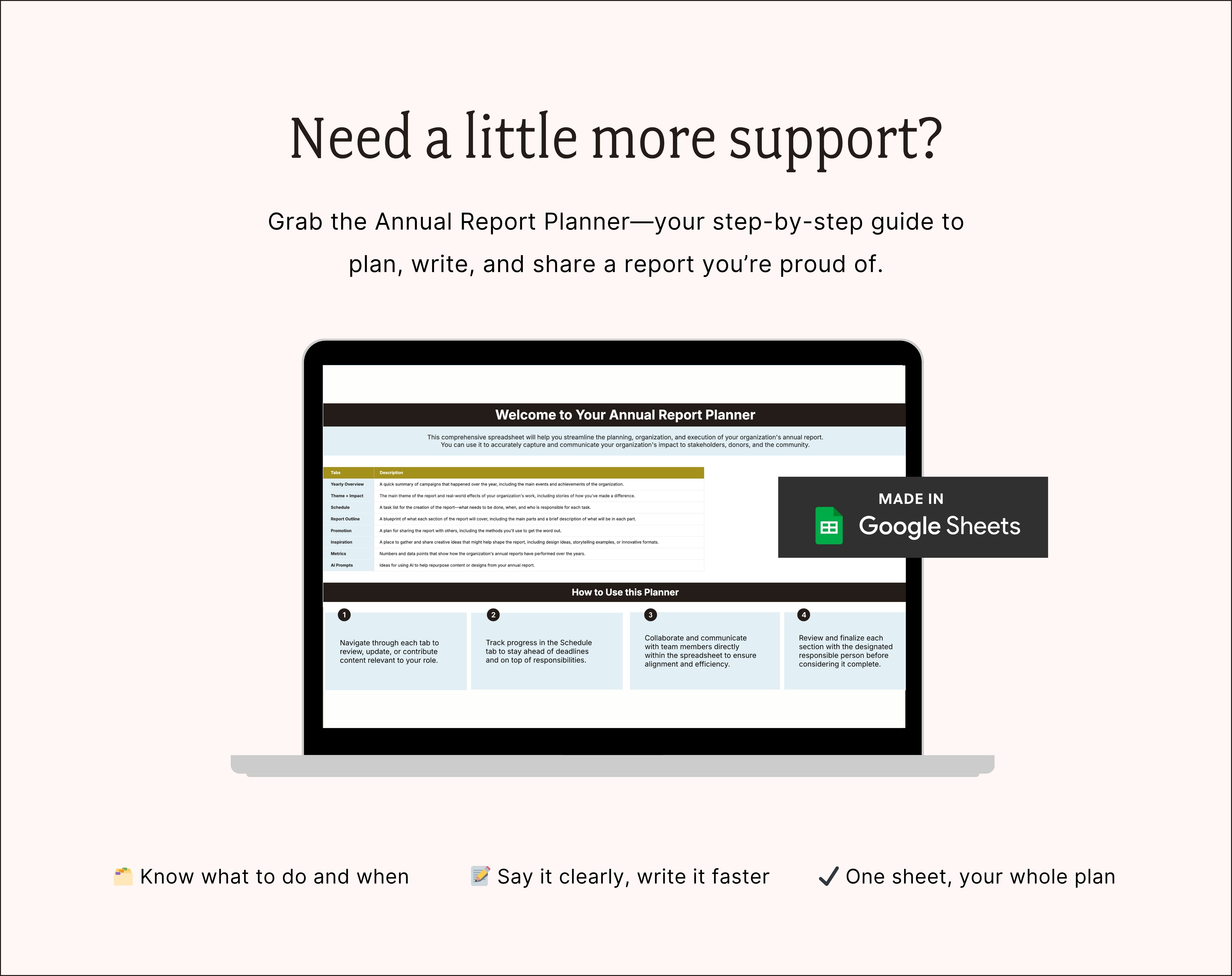You know that annual report your team pours energy into every year… the one that so much effort goes into, and yet it rarely sees the light of day after it’s done.
Let’s retire that version.
Your nonprofit annual report can be so much more than a recap.
Done well, it becomes:
- A trust-building moment for donors
- A crystal-clear snapshot for your board
- A morale boost for staff
- And a content engine you can reuse all year
This guide walks you through what that actually looks like, from structure and storytelling to design, formats, and what to absolutely stop doing.
Along the way, you’ll see places where you can go deeper with related resources on planning, design, examples, and templates. Use this as your anchor for all things annual report.
What Is a Nonprofit Annual Report (And Why It Still Matters)?
At its core, a nonprofit annual report is the story of what changed because people believed in your work.
Yes, there are numbers.
Yes, there are charts.
Yes, there may be a letter from leadership.
But underneath all of that, a strong report does three things:
- Names the change: What shifted for the people or places you serve.
- Shows the path: How your programs, partnerships, and team made that change possible.
- Builds belief: Why donors can trust you to keep doing it.
Historically, annual reports in the corporate world started as voluntary acts of transparency. Today, nonprofits sit in a similar space: you’re not filing a 10-K (that’s the formal annual financial report public companies have to submit to the government to stay transparent with investors), but your supporters still expect a clear, honest look at how you stewards funds and move the needle.
If you’ve ever wondered whether this effort is still worth it (or if it's your first time creating an annual report), you’re not alone. Many teams only start to feel the real return on a thoughtful nonprofit annual report once they see how it supports donor conversations, grant applications, and year-end appeals.
Think of your report as a narrative foundation. Everything else in your communications calendar can stack on top of it.
What to Include in a Nonprofit Annual Report (The Essentials That Build Trust)
The temptation is to include everything. Resist that.
A belief-building nonprofit annual report focuses on what readers actually need to understand so they feel confident investing their trust, their dollars, and their voice in your mission.
Here are the core pieces to include:
1. Clear, grounded mission and context
Your mission statement should be there, but don’t stop at one sentence. Give a brief, human explanation of:
- Who you serve
- What problem you’re addressing
- Why this year mattered in that bigger story
Think “orientation,” not “elevator pitch.”
2. Highlights of impact
Instead of listing every activity, pull forward:
- 3–5 major outcomes or wins
- A mix of quantitative data and qualitative stories
- Any meaningful shifts in reach, depth, or quality
If you want a deeper breakdown of what to cover, use this simple annual report checklist with must-have sections as a go-to guide for what to include and what to skip.
3. Honest financial overview
You don’t need to replicate your full audited statements, but you do need:
- Revenue vs. expenses
- Major funding sources
- How funds were allocated across programs, administration, and fundraising
Keep it visual and understandable. Donors should be able to glance at your financials and walk away thinking, “Okay. They’re using resources wisely.”
4. Donor and partner recognition
This is where you show gratitude without turning your report into a phone book.
You might:
- Highlight a handful of donor stories that illustrate different giving levels
- Share a short narrative about your donor community overall
- Thoughtfully group recognition (e.g., by program or giving circle)
The key is to make donors feel seen. A community-first approach to how you showcase donors in your annual report goes a long way.
5. Leadership voice and future direction
A leadership letter or short “Looking Ahead” section can:
- Explain important context from the year
- Name tensions or challenges honestly
- Share where you’re headed next
This is not the place for jargon or vague we’re-excited-for-the-future language. Be specific and grounded.
How to Write a Nonprofit Annual Report People Will Actually Read
Here’s the uncomfortable truth: if your report reads feels like a wall of text, numbers, and low-quality images, people will skim—at best.
Writing an annual report people actually read comes down to three things:
1. Make it skimmable first, readable second
Assume most readers will skim initially.
To help them:
- Use short paragraphs (2–4 lines)
- Add subheadings that actually say something
- Break up dense sections with callouts, pull quotes, or simple stats
- Keep sentence structure clean and conversational
You can draw inspiration from these simple, flexible annual report ideas that show how much you can do with concise content.
2. Lead with stories, support with data
Start sections with a human moment:
- A parent seeing their child thrive in a new program
- A community finally getting access to services
- A volunteer realizing the ripple effect of their time
Then bring in the numbers that prove the story isn’t a one-off. With each annual report, many teams find their footing—learning what truly makes an impactful annual report along the way.
3. Cut the “insider language”
If you use acronyms, specialized program names, or internal frameworks, quickly explain them.
A simple test: could a smart, mission-aligned stranger read your report and understand what you actually do within five minutes? If not, simplify.
Nonprofit Annual Report vs. Impact Report: What’s the Difference?
You’ve probably heard both terms used interchangeably. So what’s the real distinction?
- A nonprofit annual report is the wide-angle lens. It covers your year as a whole: finances, programs, operations, and broader milestones.
- A nonprofit impact report is a close-up. It usually focuses on a specific program, campaign, or initiative and goes deeper into outcomes and stories.
In practice, many organizations blend the two. An annual report might include a focused section that functions like an impact report for a flagship program.
If you’re trying to wrap your head around how this could look, it may help to explore how others define and use nonprofit impact reports and review real-world impact report examples nonprofits wish they’d seen earlier to spark ideas.
You don’t have to get hung up on labels. What matters most is that:
- The scope is clear
- The outcomes are honest
- The design makes the story easy to follow
Call it an annual report, an impact report, a year-end report, or a year-in-review. Just make sure it’s obvious who it’s for and what it’s supposed to do.
Best Nonprofit Annual Report Formats (PDF, Print, Interactive & More)
You’re not stuck with a single 24-page PDF anymore. The format you choose should reflect:
- How your donors like to engage
- What your team can realistically maintain
- How you plan to reuse the content
Each option serves a different need; here’s how to pick the right one.
PDF (most common)
A well-designed PDF is:
- Easy to email and host on your site
- Simple to print in small batches
- Great for embedding visuals and clear visual hierarchy
If you’re comparing digital vs. print, think about how your audience prefers to consume information and what worked in your last cycle.
Print (for key stakeholders)
Print isn’t dead, but it’s selective.
A short, beautifully printed nonprofit annual report can be powerful for:
- Major donors
- Board members
- Legislators or high-level partners
Pairing print with digital gives you flexibility: you can send a physical piece to a small, high-touch group and still serve your broader audience online.
Web-based or interactive
Building your annual report as a web page or microsite can:
- Make the content easier to explore
- Allow you to embed video, animations, or interactive charts
- Give you better analytics on what people actually read
You can see this approach in action when organizations invest in interactive digital annual report experiences that feel more like storytelling than static documentation.
Software and tools
The tools you use behind the scenes count just as much too. The right annual report software setup can simplify collaboration, content updates, and export options, especially if you’re working with a small team and need to keep things efficient.
The bottom line: choose the format that your donors and stakeholders will actually engage with and that your team can realistically maintain.
How to Design a Nonprofit Annual Report That Inspires Donor Confidence
You’ve probably heard this a million times—but for the 1,000,001st: good design doesn’t just look nice. It helps people believe you.
Here’s how to approach it with intention:
1. Start with hierarchy, not colors
Before you think about color palettes and photo treatments, nail the hierarchy:
- What needs to stand out on each spread?
- Where should the eye go first, second, third?
- What do you want someone to remember after scanning for 30 seconds?
Design choices that support stakeholder understanding (not just aesthetics) go a long way toward building buy-in and trust in your work.
2. Use visuals to guide the message, not compete with it
Infographics, charts, and icons should help readers understand your impact faster.
Well-crafted visuals can:
- Translate complex data into something graspable
- Highlight trends over time
- Show the relationship between programs and outcomes
When you’re intentional here, you tap into the same power seen in strong infographic-driven annual report layouts—the kind that turn “too much data” into something surprisingly engaging.
3. Choose photography with care
Real people. Real spaces. Real emotion.
When possible:
- Avoid overly staged stock photos
- Show your work in context
- Respect privacy and dignity in how you portray communities
The design sweet spot is when your visuals make it easy for stakeholders to see themselves in the story, whether that’s as a donor, a partner, or someone directly impacted.
4. Keep typography grounded and legible
No one should have to zoom to 200% just to read your program descriptions. Choose type that:
- Is legible on both screen and print
- Has enough contrast against backgrounds
- Uses hierarchy (sizes, weights) to guide the reader
When you step back and view the whole piece, the design should feel like a warm, visual handshake—steady, sincere, and full of purpose.
Best Practices for Creating a Nonprofit Annual Report (With Practical Examples)
Once you have the basics down, these best practices help you move from solid to standout.
1. Plan from the end backward
Ask: What do we want this report to make possible?
- Stronger major donor conversations?
- A smoother grant season?
- Clearer internal alignment?
Working backward from the outcomes is how many organizations end up with annual reports that feel as thoughtful as their internal creative and review processes instead of rushed.
2. Use examples for inspiration, not imitation
Looking at other nonprofits’ reports is useful, especially those that turn complex topics like educational equity, climate, or health into digestible stories.
Let those examples show you what’s possible in your sector, then adapt the principles to your own voice and audience.
3. Build a repeatable system
The most efficient teams treat annual report creation like a mini production cycle:
- Clear roles and checkpoints
- A shared content outline
- A reusable design system (so you’re not reinventing the wheel every year)
When you put simple systems in place, you’ll start to feel more like the teams who quietly know how to leverage templates, reviews, and timelines to make the whole production process less crazy.
How Long Should a Nonprofit Annual Report Be?
Shorter than you think.
There’s no magic page count, but a good rule of thumb:
- 8–16 pages for smaller organizations
- 16–24 pages for larger organizations with more complex programs
If your report is creeping past 24 pages, ask:
- Are we repeating information?
- Could this content live somewhere else (like our website)?
- Does every section need to be included?
You can also think about timing and workload. Teams that start earlier in the year—instead of cramming everything into mid Q4—often find they can create leaner, clearer reports.
Planning ahead might feel like just one more task, but really—it’s a head start on keeping your peace. Especially when you recognize the benefits of starting your annual report planning in the summer or noticing the early signs you’re more ready than you think.
Common Mistakes Nonprofits Make in Their Annual Reports
Let’s talk about the quiet killers of engagement.
Mistake 1: Treating the report like a compliance document
If it feels like its written by your accountant, donors will bounce. Compliance happens in your Form 990. Storytelling happens here.
Mistake 2: Wall-to-wall text
If every page looks like a brick of paragraphs, readers won’t know where to focus. Negative space is not wasted space; it’s a place to let information settle into the reader's brain.
Mistake 3: Data without interpretation
Dropping a graph on the page and walking away is not enough. Add a one-sentence insight:
- What should the reader notice?
- Why does it matter?
Guiding readers through your data helps them avoid the confusion many teams discover when they unpack the most common clarity-killing design choices in their existing reports.
Mistake 4: Relying on “free” templates that don’t fit your story
Free or generic templates can seem like a shortcut, but they often:
- Lock you into layouts that don’t fit your content
- Limit your ability to stay on brand
- Cost you more in time and revisions later
It’s a pattern many teams recognize only after learning the hard way that cheap templates can create surprisingly expensive problems.
How to Use Your Nonprofit Annual Report for Year-Round Donor Engagement
Here’s where most organizations underestimate what their report can do. Your nonprofit annual report is not a one-and-done artifact. It’s the place where you build the layouts, components, and messaging your team will reuse all year.
And if you’re in the middle of a rebrand rollout, it becomes even more valuable. Your annual report is the smartest place to ground the transition because it’s the one asset deep enough to show your team how the new brand should actually behave in real, long-form donor communication.
The hierarchy, tone, visual patterns, and data styles established in the report start quietly shaping everything that follows, giving your entire team a consistent example to build from.
Here’s how to maximize its use so it supports your next round of communications:
1. Turn sections into email and social content
Each major section can become:
- A short email story
- A carousel of key stats
- A donor spotlight
- A mini program deep-dive series
When your original layout is built with repurposing in mind, it’s much easier to spin your report into ongoing communication, especially if you’ve started by reimagining how your reporting assets can support your broader storytelling.
2. Use visuals in presentations and campaigns
Pull:
- Impact infographics into decks for funder meetings
- Donor quotes into appeals
- Before/after program snapshots into events and webinars
Interactive or web-based versions of your report can be particularly powerful here, giving you flexible assets you can reference all year long.
3. Create donor-specific follow-ups
For major donors or key partners:
- Send a short, personalized note referencing a specific section of the report
- Highlight a program they helped make possible
- Invite them to a conversation about what’s next
This is where a thoughtfully designed annual report quietly works on your behalf behind the scenes.
Actionable Tips to Get Started on Your Nonprofit Annual Report
Let’s bring this down to earth. The longer your report stays unfinished, the more opportunities you miss to show up, stand out, and build belief. Start strong here.
Tip 1: Give yourself a real runway
Work backward from your ideal release date and map:
- Content deadlines
- Design milestones
- Review checkpoints
Even a simple three-step prep process (outline → gather content → refine and review) can help you stay ahead of the rush that derails so many well-meaning teams.
Tip 2: Start with a messy outline
Open a doc and create placeholders:
- Leadership letter
- Mission and context
- 3–5 major outcomes
- Financial summary
- Donor recognition
- Looking ahead
Then start dropping in bullet points. You can refine and wordsmith later.

Tip 3: Use templates to protect your time (not box you in)
The right templates:
- Reflect your brand
- Give structure without feeling generic
- Make it easier to repurpose pages and layouts later
When templates are thoughtfully designed for small nonprofit teams, they become a support system—not another tech hurdle.
FAQs About Nonprofit Annual Reports
1. Do we really need to create a nonprofit annual report every year?
You’re not legally required to publish a glossy report, but you are required to file Form 990 (or its equivalent).
A public-facing annual report is one of the most effective ways to translate that compliance into something donors can actually connect with. If you're wondering whether nonprofit annual reports are still relevant, we’ve broken it down.
2. How early should we start planning?
Earlier than feels comfortable.
Many teams kick off:
- Content planning in late spring or early summer
- Data collection in late summer
- Design and layout in the fall
Starting early helps you avoid the all-too-familiar rush that happens when everything collides with year-end fundraising.
3. Who should be involved in creating the report?
At minimum:
- One owner to drive the process
- Program leads for content and outcomes
- Finance for accurate numbers
- A designer (internal or external) who understands nonprofit storytelling
If you’re working with an external partner, look for someone who can bring a clear, documented process to the table so you’re not reinventing the wheel each year.
4. How polished does it need to be?
Polished enough to reflect the care you bring to your work. That doesn’t mean expensive or flashy—it means intentional.
If the design improves stakeholder understanding, clarifies your messaging, and feels aligned with your mission, you’re in the right zone.
Bringing It All Together
A nonprofit annual report doesn’t have to be heavy, tedious, or purely “for the board.”
It can be:
- A clear, honest snapshot of a complex year
- A piece your team is proud to share
- A trust-building touchpoint donors actually want to open
- A content well you draw from all year
When you combine grounded storytelling, thoughtful structure, and design that respects your reader, the report stops feeling like a chore and starts acting like an asset.
If you’d like support turning your draft into a clean, on-brand, belief-building report, our Annual Report Design Intensive is built for exactly this—fast timelines, high care, and designs you can reuse across channels.
Prefer a more DIY route with structure and strategy baked in? Our Annual Report Template Kits give you flexible, nonprofit-specific layouts you can customize in Canva without starting from zero.
Either way, your next report can do more than recap the year. It can quietly build belief, one thoughtful page at a time.

Donor Thank You Cards
Download the free pack to get 4 postcard designs (7x5in) with editable messages.







.png)



